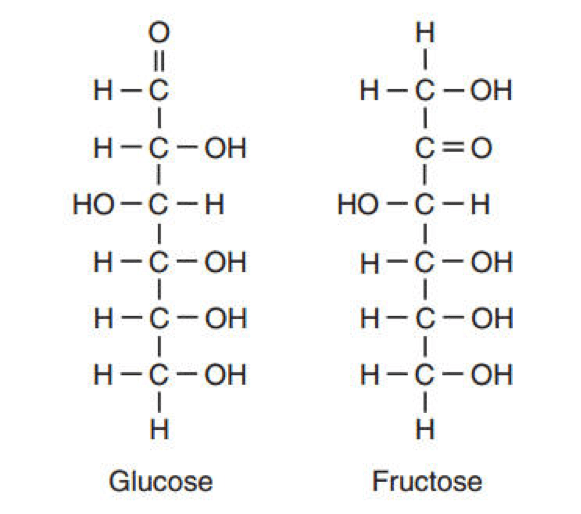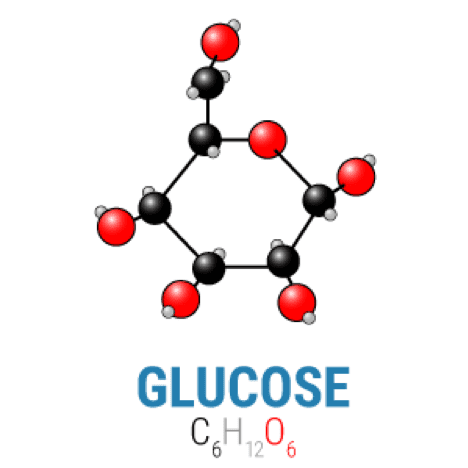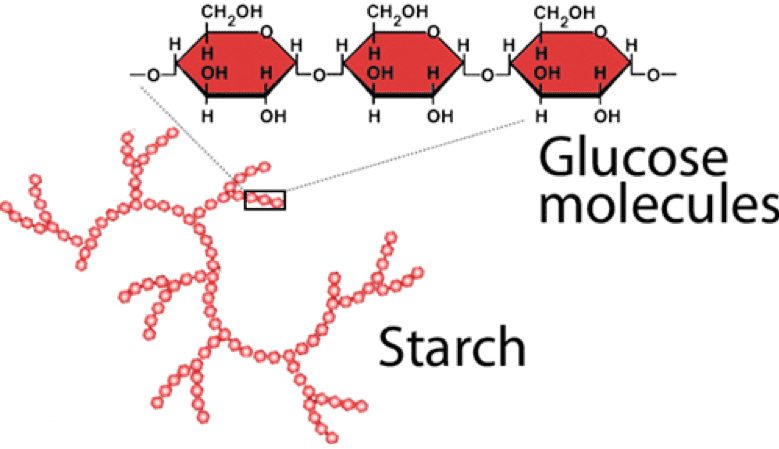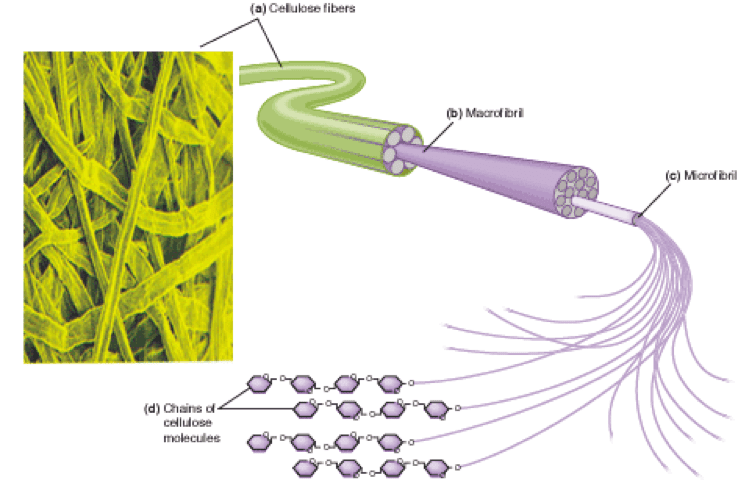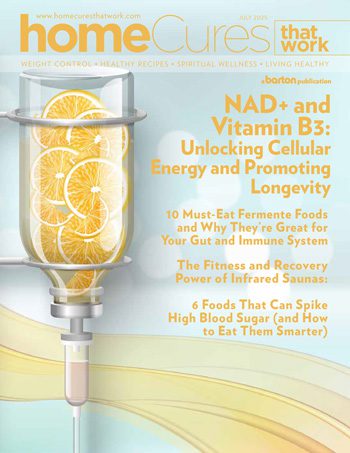The Difference Between Fiber, Starch and Sugar Carbs
We often think sugar must taste sweet, but most of the sugar we eat is not sweet at all. Sugar is carbohydrate — all carbohydrates are made from sugar. The carbohydrates in the foods we eat come in three different types:
- Simple sugars
- Starches
- And fiber
These are all made from the same building blocks: sugar. Thus, when we are talking about carbohydrates, we are talking about sugar.
Wherever there is life, you will find carbohydrates. Plants are made from carbohydrates, and all animals use them for energy. Carbs are a miracle. They store the energy from the Sun in a little molecule for us to use later.
When you burn wood in your fireplace, the heat and light is the release of energy that the tree got from the Sun. All carbohydrates come from the same source – plants. You may think that the structure of plants comes from the soil, but the plant doesn’t even need soil, it all comes out of the air and water. The plant takes carbon dioxide (CO2) out of the air and water (H2O) from the ground and makes it into carbohydrate (CH2O) and oxygen (O2). This conversion takes a lot of energy, which is supplied by the Sun. The chemistry looks like this.
CO2 + H2O = CH2O + O2
This is how plants make the oxygen we breathe as they are making carbohydrates for them to use. “Carbo” refers to the carbon atom, and “hydrate” refers to water (H2O). The way they use carbohydrates is amazing! They take each one of these CH2O molecules and string them together to form “polymers,” or strings, of the same molecules. When there are six of them strung together it makes a sugar such as glucose and fructose.
If you count them you will find that each of these sugar molecules has six carbon atoms ©, six oxygen atoms (O), and twelve hydrogen atoms (H). So, it can be written as 6(CH2O). The picture above is simple to see that they are carbo-hydrates, but the structure of sugars forms a ring, instead of a straight line.
These are the primary building blocks of all plants, and the primary energy source of plants, bacteria, archaea, and animals. These molecules have a lot of energy, manifested by burning them. If you are roasting a marshmallow in the fire and you leave it in too long, it will start on fire – that is the energy being released from these sugar molecules, which came from the “Sun” (fire).
The plants can take these and make more polymers, stringing them together to form starches. Starch is just a long chain of connected sugar molecules.
Even the fiber part of plants is made from sugar. Wood is cellulose, which is a chain of glucose molecules, but we can’t digest it because we don’t have the enzymes needed to break the chain.
So, your campfire is burning sugar… your marshmallow that caught on fire is burning sugar…the starch in bread burns sugar when you leave it in the toaster… and when you eat what is left, you can “burn” the sugar for energy.
Cotton fiber is a string of sugar molecules as well. Your blue jeans are made of sugar (cotton), as is that “synthetic” rayon shirt. The money that you bought the clothes with is made of sugar. It’s all sugar!
Fiber
Long chains of sugar molecules that we cannot use for energy are called “fiber” simply because we aren’t able to digest it, or break the chains. Thus, fiber goes through our digestive tract without getting broken down and ends up in the colon, where bacteria can use some of them. What to us is just fiber might be a feast for bacteria, especially the good kind. “Good” bacteria feed on the things we don’t use, while “bad” bacteria feed on the same stuff we do – simple sugars and starches.
There are many types of chains of sugar molecules that we don’t digest that feed our good bacteria, called prebiotics, not to be confused with PRObiotics, which are the good bacteria themselves. Prebiotics are found in fruit, vegetables, beans, nuts, and whole grains. When food is processed, the fiber is generally removed. Ironically, many people eat food that has the fiber removed, and then add spoonfuls of fiber, like psyllium seeds, orange pulp, or chicory root, to their diet. The best way to get fiber in your diet is to simply eat whole foods.
There are three major classes of prebiotics that are being studied:
- Inulin
- Oligosaccharides
- Arabinogalactans
Each of these classes of carbohydrate fiber are used by different bacteria. If we take only one type, we can get “dysbiosis” or overgrowth of one type of bacteria. Since it is most healthy for the colon to have many types of bacteria, we need to eat many types of fiber, or prebiotics. Variation in the diet is essential, and thus, your food should be your primary source of prebiotics. The following are a few examples of how to get these wonderful carbohydrates.
| Food | Grams of fiber per serving[1] |
| Beans | 15 |
| Berries | 8 |
| Whole grains | 4 |
| Peas | 16 |
| Spinach | 4 |
| Almonds | 4 |
| Zucchini | 3 |
| Broccoli | 5 |
| Apple | 4 |
| Potato | 4 |
| Avocado | 7 |
You can see that legumes (beans, peas) are a great source of fiber. Avocado is also excellent. Fiber, or prebiotics, are the kinds of carbohydrates that you should not limit. In eating high-fiber foods you build a healthy gut, immune system, brain and body. You can eat as much of this as you want – and everyone should get more than they currently eat.
Starch
A chain of glucose that we can digest for energy is starch. From the moment we put starch into our mouth, such as when we eat bread or a potato, the amylase enzyme in our saliva starts making the starch into sugar. We were told in school that if we put a cracker in our mouth and leave it there, then it will become sweet. I tried it, and I didn’t taste anything sweet. But, despite not tasting glucose, the starch from the cracker is being broken down as we chew as it “turns into” sugar. The following are a list of relative amounts of starch from foods.
| Food | Grams of starch per 100 grams of food |
| Brown rice | 31 |
| White rice | 23 |
| Spaghetti | 21 |
| White bread (average) | 46 |
| Whole grain bread (average) | 39 |
| Cheerios | 57 |
| Oatmeal | 9 |
| Hummus | 9 |
| Beans/Lentils | 15 |
| Peas | 7 |
| Tofu | 0.9 |
| Potatoes | 14 |
| Yam | 27 |
| Broccoli | 0.1 |
| Avocado | 0.1 |
| Carrots | 0.2[2] |
You can see that grains are high in starch. Even though the white bread is higher in starch, the whole grain bread is still very high, relative to other foods. And, even though Cheerios advertises only one gram of sugar, it has 17 grams of starch per 28g serving! Potatoes are lower in starch than grains. Most interesting, though, is the “starchy vegetables” such as carrots have very little starch in them.
Since starch turns into sugar, there is little difference from eating candy or sweet things. It is important to know how much starch is in foods so you can know how much sugar you are getting.
Simple Sugars
The sweetest things in life are sugars. We are told that there are good sugars, and bad sugars. There is nothing of the sort. Sugar is just sugar. It’s great! It tastes good, and we need it for energy.
Simple sugars are made of one or two sugar molecules. Glucose is the main simple sugar we use for energy and is what makes up all the starches we discussed earlier. Other simple sugars include:
- Fructose
- Sucrose (a fructose and a glucose bound together)
- Lactose (milk sugar made of a glucose and galactose)
Fructose is sweeter than glucose so the higher the fructose content, the sweeter the sugar.
Table sugar is sucrose, which comes from sugar cane, or sugar beets. It’s always 50% glucose and 50% fructose.
Corn syrup is mostly glucose, but it can be processed into about 45% glucose and 55% fructose to make high-fructose corn syrup, which is about the same as honey, which bees make from sucrose, and still has a little sucrose in it.
Maple syrup is sucrose. Coconut sugar is sucrose.
Agave nectar is around 90% fructose, making it one of the sweetest sweeteners around.
Here is a list of foods and their sugar content.
| Food | Simple Sugars (grams per 100 grams)[3] |
| Apples | 13 |
| Apricots | 9 |
| Avocado | 1 |
| Banana | 15 |
| Berries | 8 |
| Broccoli | 2 |
| Carrots | 5 |
| Celery | 1 |
| Melon | 8 |
| Cherries | 14 |
| Grapes | 18 |
| Orange | 9 |
| Milk | 5 |
| Tomato | 3 |
| Dates | 64 |
| Raisins | 65 |
| Milk Chocolate | 51 |
Notice the dried fruits, raisins and dates, contain a lot of sugar because taking out the water concentrates the sugar. Foods like meats, fish, and cheese have very little sugar, less than one percent.
All this sweetness is wonderful, but when we get too much it’s toxic. Most deaths in developed countries are due to sugar toxicity.
Diabetes, heart disease, cancer, Alzheimer’s disease, and kidney failure are mostly due to the toxicity of sugar and starch. Too much of a good thing is bad.
Thus, the reason to cut back on sugar is the same reason we talk of quitting alcohol. When people become toxic because they have taken in too much, they must cut back to detox.
The Barton Publishing Diabetes Reversal Program outlines how this is done. The simple sugars and starches are limited so the body can get rid of the excess that has accumulated over the years, and begin to use fat for energy. Once the body is good at burning fat, the carbs can be increased. At the same time, there is no limit on fiber carbohydrates. This is why it’s important to understand how to read a label.
How to Read a Label for Sugar
The first thing to consider when reading a label is the “SERVING SIZE.” Sometimes, you may buy a bag of chips and find that what you thought was one serving turns out to be five. So, if you’re going to eat the whole bag, you must multiply the carbs on the label by five. The following is a hypothetical food label.
The “TOTAL CARBOHYDRATE” on the label refers to all carbs — simple sugars, starch, and fiber. The next is “DIETARY FIBER” which is good for our colon, and then “SUGARS,” which is just the simple sugars. Starch is not included, but you can know how much starch there is by subtracting fiber and sugar from the total. The example above has 2g of starch.
The label says this food has 4 grams of total carbs. When we subtract the fiber that we do not use for energy, we have a net carb count of 3 grams. If you eat all 5 servings in the package, that makes 15 grams of net carbohydrate, or sugar and starch, and only 5 grams of fiber.
Try this exercise: create a label for an Avocado. A serving is 100g (about half a large avocado), each type of carbohydrate is listed above. You will be amazed at how healthy this fruit is!
Carbohydrates are not good or bad, they are things we need. We need fiber. We need starch, and we need simple sugars. The reason people put judgments on them is because we eat too much of the things we love, starch and sweet simple sugars, while avoiding the things we don’t, fiber. Most people get a large portion of their calories from sweet drinks, like soda pop and juice. Though juice may have some nutrients, the fiber from the fruit is removed. It’s just a processed food.
A good way to get all the fiber without too much sugar and starch is to avoid processed foods or prepared foods. Eat the fruit, instead of drinking it. Also, if you eat foods that don’t have a “Nutrition Facts” label like the one above, and mostly vegetables, you will surely get all the nutrition you need without ever becoming toxic.
[1] https://www.todaysdietitian.com/newarchives/063008p28.shtml
[2] http://www.kickas.org/ubbthreads/ubbthreads.php?ubb=showflat&Number=143543
[3] https://www.nutritionvalue.org/



